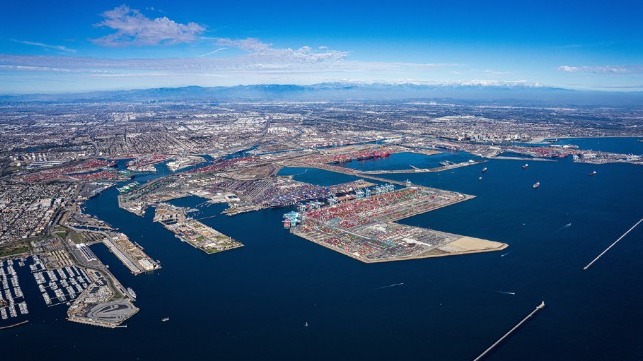SoCal Ports Take Steps to Accelerate Movements as More Records are Set

With vessel congestion continuing to rise and breaking records established only days before, the ports of Los Angeles and Long Beach are taking further efforts to deal with the surging container volumes and growing bottlenecks in the supply chain. The Port of Los Angeles alone reports that volumes are up 30 percent year to date at its container terminals with the expectations that significant volume will continue throughout this year and into 2022.
In a rare joint announcement, the twin ports in the San Pedro Bay said after consultation with multiple supply chain stakeholders and the U.S. Department of Transportation, that they will enhance the ports’ landside operations to help meet the unprecedented growth in cargo volume.
Specifically, both ports will expand the hours during which trucks can pick up and return containers. Mario Cordero, Executive Director of the Port of Long Beach, announced that Long Beach will take the first step towards a 24/7 supply chain by maximizing nighttime operations. Port of Los Angeles Executive Director Gene Seroka announced that the Port of Los Angeles will expand weekend operating gate hours. Dubbed “Accelerate Cargo LA,” the Port of Los Angeles’ program will operate on a pilot basis to ensure that gate availability meets cargo demands and provides greater transparency to improve efficiency. In addition, both ports have called on marine terminal operators to incentivize the use of all available gate hours, especially night gates, to reduce congestion and maximize cargo throughput capacity.
The ports of Long Beach and Los Angeles will work closely with the trucking community to ensure that all truck operators understand how to take advantage of incentivized gate hours as well as the expanded opportunities that will be created to move cargo during non-peak times. In addition to expanded hours and incentivized reservation priority, the ports urge terminals and the trucking community to consider other corrective measures.
The announcement came at the end of a week in which the port complex set and broke multiple records for the number of vessels arriving and waiting for terminal space. Wait times for containerships in the anchorage are also steadily increasing approaching nine days on a 30-day moving average for the Port of Los Angeles. Experts said that actions were urgently needed with the forecast that the volume of imports coming from China and Asia will continue to increase.
After setting several new records last week, the Marine Exchange of Southern California reported that the southern California port complex set a new record of 73 vessels in the anchorage and drift areas over the weekend. The anchorages remain full and over the weekend the number of vessels continued to increase driving the drift areas beyond the anchorage to a new record of 37 vessels today, up from 28 set late last week. This includes 29 containerships up from 23 just days earlier.
On September 19, the port complex set a new record with a total of 100 containerships. This includes 70 containerships at anchor or drifting and awaiting orders or a berth with 16 of those vessels being mega-container ships with a capacity of over 10,000 TEUs. Among those ships alone there is a capacity of nearly 200,000 TEU.
According to Captain Kip Louttit, Executive Director of the Marine Exchange, traffic will continue at elevated levels but may decline slightly in the next few days. In the first part of this week an additional 29 vessels of all types are scheduled to arrive, but over the same three-day period 41 vessels of all types are scheduled to shift from an anchorage or drift area to a berth.
While the ports have been straining to handle these volumes, the landside has increasingly become a bottleneck. The latest efforts hope to address the challenges with moving containers by truck, but the rail links remain basically full with reports of backups building across the intermodal systems. The latest agreement is the first effort by the Biden-Harris Administration’s Task Force on Supply Chain Disruptions. In June, President Joe Biden announced a 100 day supply chain review and in August named a port envoy to work with the departments of Transportation, Commerce, and Agriculture to ease bottlenecks and facilitate the flow of goods across the country.
